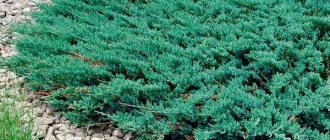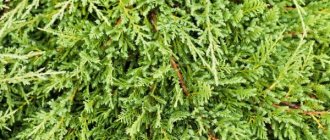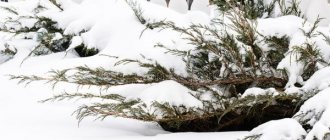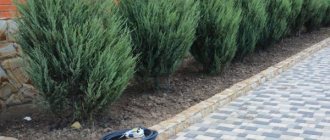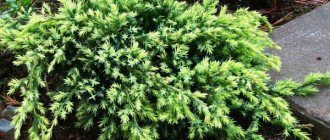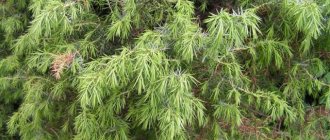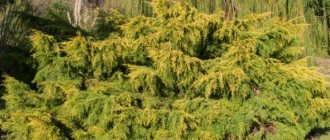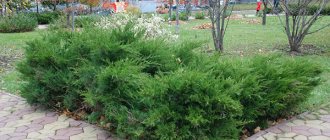Characteristics of the variety
Description and characteristics of the Juniperus horizontalis Lime Glow variety:
- plant height - 40 cm;
- width - 1.5-2 m;
- bark - gray-brown, dense;
- the crown of young shrubs is cushion-shaped, and that of adults is funnel-shaped;
- annual growth is no more than 10 cm, so juniper of this variety is a slow-growing crop;
- The needles of young bushes are green; with age they become bright yellow. In winter, the needles transform again and acquire an orange-bronze hue;
- broad-shaped fruits, about 4 cm long;
- the cones are bluish-black.
Winter hardiness is high. Horizontal juniper can withstand temperatures down to -26°C. Therefore, it is possible to plant this crop in all regions of the country. Life expectancy, subject to all care rules, is no more than 400 years. If you want to extend this period, then you need to replant the plant to a new location every 50 years.
Correct fit
It is very important to plant horizontal juniper correctly so that the plant develops within the time frame specified by the manufacturer and dies from changes in temperature. Monitor the optimal timing for planting, and also choose planting material responsibly.
Important! The cones of the horizontal juniper Lime Glow are poisonous.
Purchase planting material from specialized nurseries. In them you can purchase healthy seedlings, as well as receive recommendations for caring for them. It is important to monitor the quality of the soil, since the plant prefers to grow in nutritious soil with a neutral pH level.
How to choose a seedling
When choosing a seedling, it is necessary to take into account its age. Plants that are 2-3 years old are suitable for planting in open ground. Older shrubs will take a long time to take root and will not have time to acclimatize before the onset of winter. Young plants can die from the slightest change in temperature.
You should also pay attention to the condition of the root system and crown. This will be discussed in more detail below.
Root system
When choosing a seedling, take into account the characteristics of the root system. The optimal length is 20 cm. Choose planting material with a closed root system. When purchasing, consider the containers in which the plant is stored. It is best if it grows in pots rather than bags, where the roots are quickly damaged. If you purchase a seedling with an open root system, you need to start planting immediately. Otherwise, the rhizome will be damaged by exposure to air.
Did you know? Juniper has its own interpretation in dreams. If you dream of this plant, it means that wealth and good luck await you in all your endeavors.
Crown
The optimal width of the crown of a young seedling is 20 cm. It should be uniform and dense. There should be no brown or red spots on the surface of the crown that indicate the presence of diseases. The optimal size of a seedling is 20 cm.
Selection and preparation of a site
It is necessary to plant horizontal juniper varieties Lime Glow in the spring, when the root system is growing. This will also allow the plant to root into the soil to withstand winter frosts.
When choosing a seat, you need to consider some features. You cannot grow juniper next to apple trees, because these crops have similar diseases and parasites. Also, avoid planting near roofs. When the snow melts, it can damage the crown of the bush. It is preferable to plant plants in sunny areas so that the needles become brighter. The garden plot must have nutritious soil. Juniper develops best in loam or black soil.
Read the description of Golden Carpet juniper.
Preparing the soil for planting is as follows:
- Dig up the area.
- Add humus (3 buckets per 1 m²).
- Water the soil (50 liters per 1 m²) so that fertilizers penetrate better into the soil.
Landing algorithm
After a month you can start planting.
Important! When planting, the root collar is left above the surface of the ground, raised by 5-6 cm. With its help, the oxygen necessary for the plant to develop will penetrate into the roots.
The technology is as follows:
- Dig holes 30 cm deep and 40 cm wide.
- Add a 10cm layer of broken bricks to regulate soil moisture levels.
- Sprinkle the drainage with a nutrient mixture, combining garden soil, sand and peat in equal proportions.
- Place the seedling inside and water it with 5 liters of water.
- Fill the hole with garden soil.
- Pour in 10 liters of water.
- Mulch the tree trunk circle with peat or spruce branches (the mulch layer should be 20 cm).
Reviews
Gardeners note the decorative value of juniper at any time of the year. They like that the symmetrical and dense crown does not need to be additionally cut, covered for the winter, or protected from sunburn.
Landscapers point out that the advantage of the variety is its slow growth, which preserves the intended composition for a long time.
Beginners appreciate this plant because of its minimal care, unpretentiousness and high immunity to disease.
Numerous varieties of horizontal juniper are actively used in landscape design. Juniper Lime Glow is no exception. A dwarf shrub with decorative needles and a non-capricious disposition is excellent for decorating alpine hills and low borders.
A long-living, winter-hardy plant will help strengthen the slopes and give the site a unique look.
Care instructions
In the process of growing horizontal juniper varieties Lime Glow, you should provide it with proper care. Adjust the watering interval to ensure the soil is not too waterlogged. Also, do not forget about fertilizing and loosening the top layer of soil. It is important to trim the crown so that it maintains its brightness and splendor.
Watering and fertilizing
Horizontal juniper is a drought-resistant crop. Therefore, you need to water the plants no more than once a month. 20 liters of water are poured under each bush. If you live in regions with a hot climate, then you need to irrigate the juniper 2 times a month. The shrub prefers to grow in humid air. Therefore, watering is carried out using the sprinkling method so that water also reaches the crown.
It is not recommended to heavily fertilize the soil, since Lime Glow juniper does not develop well under such conditions.
A total of 2 feedings are required during the season:
- in the spring, 300 g of nitroammophoska is added to each bush;
- In autumn, mineral fertilizers are used (50 g of superphosphate per plant).
Reproduction methods
There are several ways to propagate the horizontal juniper variety Lime Glow. Most often, gardeners use the cutting method. The material needs to be prepared in the spring. To do this, you need to cut the cuttings (up to 25 cm long) along with the wood.
It will be useful for you to read about growing juniper from seeds.
Free the lower part from the needles and plant it in a container filled with a nutrient mixture (sand and peat in equal proportions). Place the container in a warm place. Care consists of weekly watering. After 2 months, after the roots have developed, transplant to a permanent place in open ground.
You can also propagate horizontal juniper by layering in early autumn. To do this, press healthy shoots to the ground and dig in. Caring for plants is the same as in the case of mature shrubs. In the spring, when the root system is developed, separate the cuttings from the mother plant and replant them in a permanent place.
Diseases and pests
Preventive measures will help keep the plant healthy
The Lime Glow variety, like all conifers, has good immunity. But even this juniper, torn out of its usual habitat, surrounded by many other species carrying various diseases, may not be able to withstand their pressure.
External signs of the disease may be:
- yellowing of needles;
- dry shoots;
- rust;
- mold.
The main danger to plants is fungi. They provoke:
- rust;
- drying of shoots;
- Alternaria blight;
- fusarium;
- necrosis of the cortex;
- Schutte (brown gray mold).
A traditional means of combating fungal diseases is Bordeaux mixture, where the active ingredient is copper sulfate. Modern fungicides of chemical and biological action can also be used.
Another danger to juniper are insect pests:
- scale insect;
- aphid;
- gall midges;
- shoot moth;
- spider mite
Unlike fungi, which grow inside plants, insects are located outside. An attentive Lime Glow owner will easily spot them. Available insecticides can effectively combat them.
To prevent infection, you should remove last year's litter and loosen the soil before frosts so that pests have nowhere to overwinter.
Application in landscape design
In nature, the Lime Glow variety is found near ponds and mountains. Therefore, gardeners specializing in landscape design often plant juniper crops to decorate decorative ponds in garden plots. You can also plant plants on the lower rows of rock gardens. Due to the shape of the bush's crown, it is used to cover the soil on paths or decorate open areas of the garden. To get a juniper carpet, it is enough to plant 3 bushes per 1 m².
Most often, the Lime Glow variety is planted next to barberry, heather, paniculate hydrangea or evergreen coniferous varieties.
Juniper is often used for single plantings. It can also be combined with other plants. Thanks to its bright crown, reminiscent of the color of a lemon peel, the culture goes well with flowers of lilac or purple hue. Looks good against the background of decorative lemons, which gardeners also grow at home.
So, now you know how to grow horizontal juniper variety Lime Glow at home. Despite the ease of care, you need to carefully care for the crop so that it pleases you with the rich, bright colors of its needles and lush crown.
Conditions for growing juniper Lime Glow
The plant is unpretentious, but if you create conditions close to natural for the juniper, the shrub will respond with good growth and a bright crown color.
According to the description, Lime Glow juniper is a drought-resistant perennial crop that prefers light soil, sunny areas or transparent partial shade.
If the bush is in the shade, its appearance may change. The beautiful yellow shade of the needles turns into the usual green color.
In nature, horizontal junipers live on the eastern coast of the United States and Canada, on sandy light soils that are typical of the shores of lakes and rivers. The plant does not need special soil nutrition, but if the juniper is planted in a dense substrate with poor access to water and air, growth slows down, the seedling looks depressed. The proximity of groundwater, as well as stagnation of melt or rain moisture leads to the same result, and sometimes to the death of the plant.


